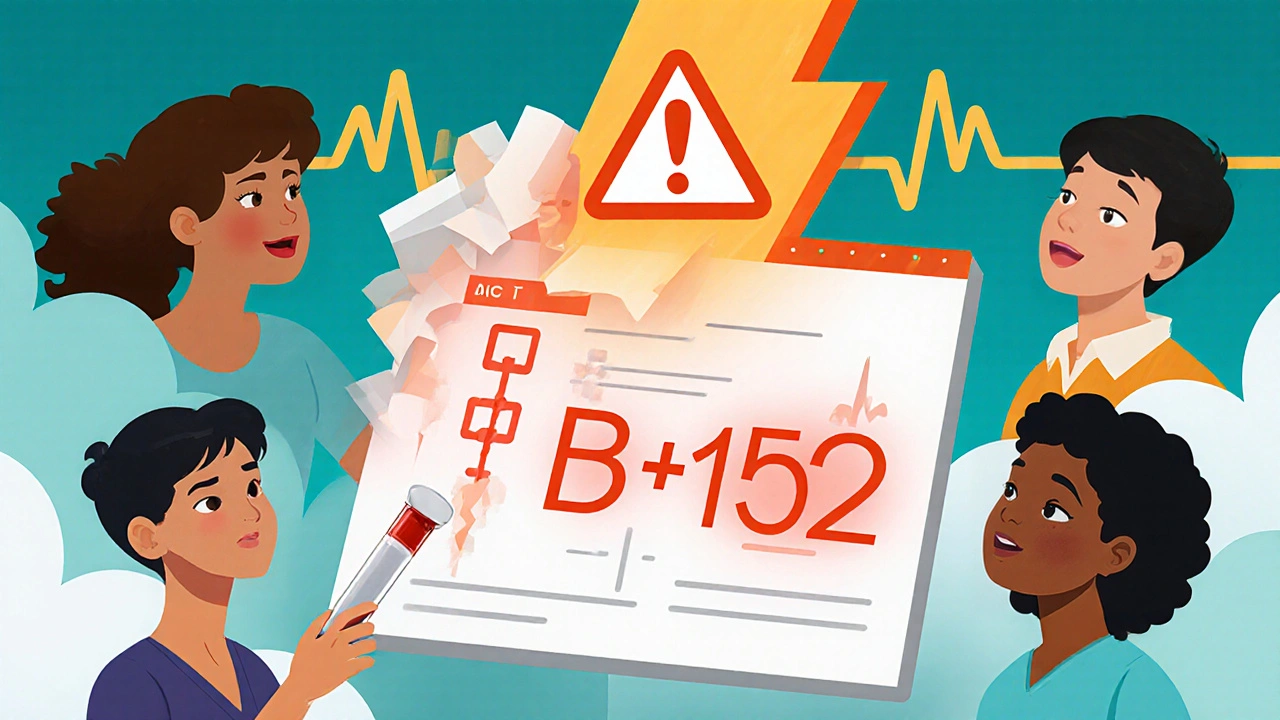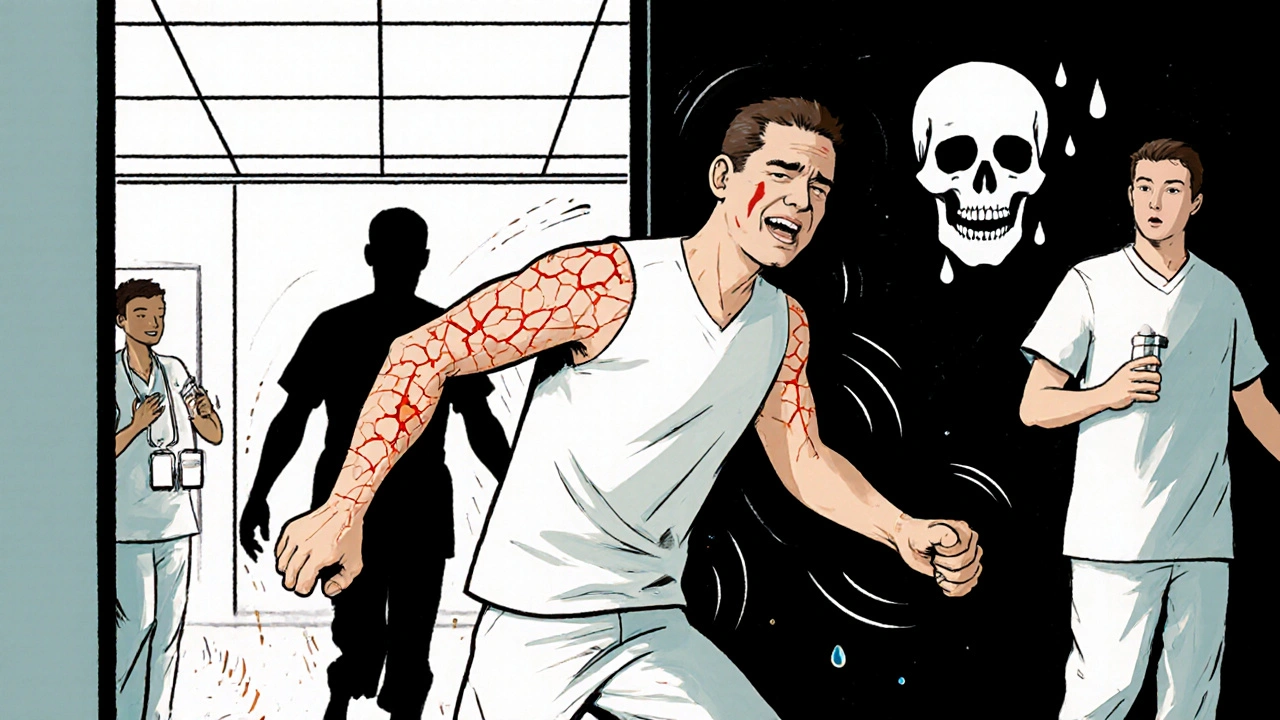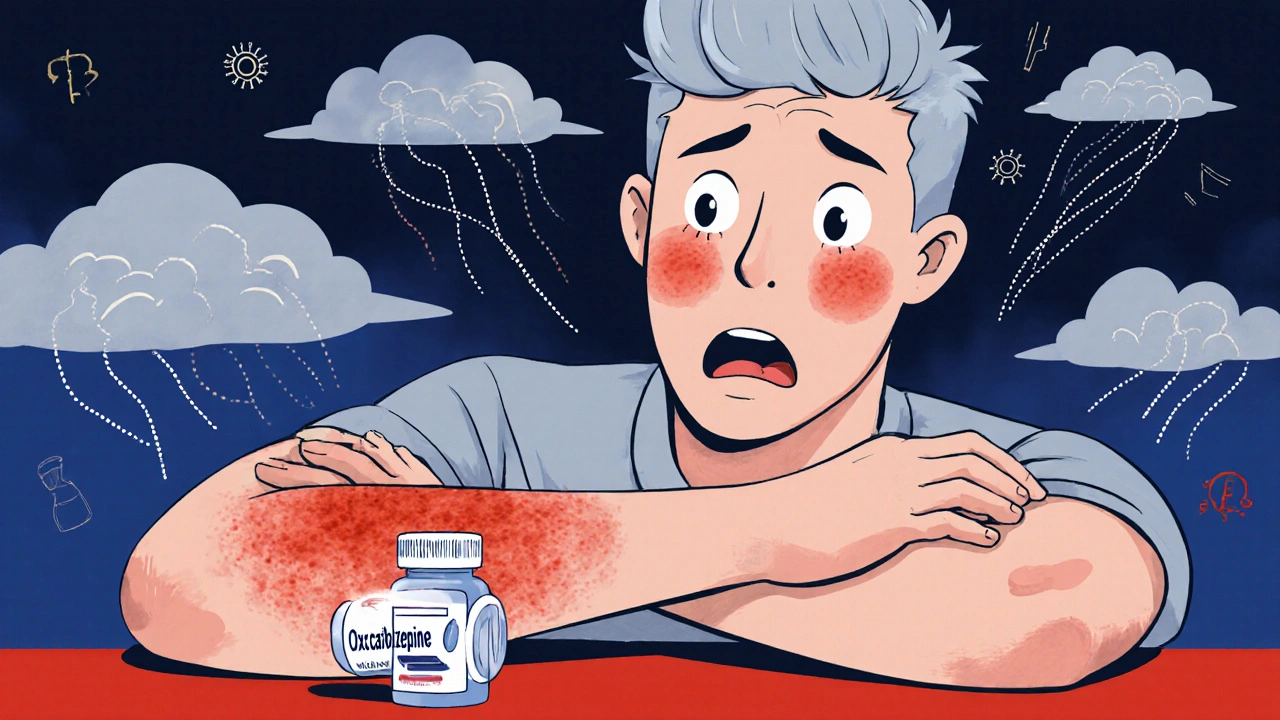If you’re taking oxcarbazepine for seizures or nerve pain, you’ve probably been told to watch for dizziness or fatigue. But there’s one side effect that can turn serious-fast. Skin reactions from oxcarbazepine don’t always start as a mild rash. Sometimes, they begin with flu-like symptoms and a red, painful patch on your skin. By the time it spreads, it could be life-threatening.
What kind of skin reactions can oxcarbazepine cause?
Oxcarbazepine, sold under brand names like Trileptal and Oxtellar, is an antiepileptic drug used for partial seizures and sometimes for bipolar disorder or neuropathic pain. While most people tolerate it well, about 1 in 1,000 users develop a serious skin reaction. The most dangerous ones are:
- Stevens-Johnson Syndrome (SJS) - Starts with fever, sore throat, and burning eyes, then a blistering rash that spreads and peels off like a burn.
- Toxic Epidermal Necrolysis (TEN) - A more severe form of SJS, where over 30% of your skin detaches. This is a medical emergency.
- Drug Reaction with Eosinophilia and Systemic Symptoms (DRESS) - Rash, swollen lymph nodes, fever, and organ inflammation (liver, kidneys).
These reactions usually show up within the first 2 to 8 weeks after starting the drug. But in rare cases, they’ve appeared after months of use. If you’ve been on oxcarbazepine for a year and suddenly break out in a rash, don’t assume it’s just allergies. Get it checked.
Who’s at higher risk?
Not everyone who takes oxcarbazepine gets a skin reaction. But some people are far more vulnerable. Genetics play a big role. If you have the HLA-B*15:02 gene variant, your risk of SJS/TEN jumps dramatically. This variant is common in people of Asian descent-especially Han Chinese, Thai, Malaysian, and Filipino populations. The U.S. FDA and European Medicines Agency recommend genetic testing before starting oxcarbazepine for patients with this ancestry.
Other risk factors include:
- Starting with a high dose instead of gradually increasing it
- Taking other drugs that affect liver metabolism, like carbamazepine or phenytoin
- Having a history of allergic reactions to other antiepileptic drugs
- Being under 18 or over 65
If you’re unsure about your genetic risk, talk to your doctor. A simple blood test can identify the HLA-B*15:02 variant. It’s not routine everywhere, but if you’re from a high-risk group, ask for it.
What should you look for?
Early warning signs aren’t always obvious. Most people think of a rash as itchy and red-but with oxcarbazepine, it’s often worse than that. Here’s what to watch for in the first 8 weeks:
- Unexplained fever without a cold or flu
- Painful red or purple skin patches, especially around the mouth, eyes, or genitals
- Blisters or peeling skin, even if it’s just a small area
- Swelling of the face, lips, or tongue
- Red, watery eyes or difficulty swallowing
- Flu-like symptoms (fatigue, body aches) combined with a rash
Don’t wait to see if it gets better. If you notice any of these, stop taking oxcarbazepine immediately and go to the emergency room. Don’t call your doctor first-go directly to urgent care. Delaying treatment increases the risk of organ damage or death.

What happens if you get a reaction?
If you develop SJS, TEN, or DRESS, you’ll need to stop oxcarbazepine right away. You’ll likely be admitted to a hospital-often a burn unit or intensive care unit. Treatment includes:
- Stopping the drug permanently
- IV fluids and electrolytes to support your body
- Pain management and wound care for damaged skin
- Antibiotics if there’s infection
- Immunoglobulins or steroids in severe cases
Recovery can take weeks to months. Skin regrows slowly. Scarring is common. Some people lose vision if their eyes were affected. Others have long-term liver or kidney damage. And once you’ve had one of these reactions, you can never take oxcarbazepine-or carbamazepine-again. Cross-reactivity is almost guaranteed.
What are the alternatives?
If you’ve had a skin reaction to oxcarbazepine, you need a different seizure or nerve pain medication. But not all are safe. Carbamazepine has a similar chemical structure and can trigger the same reaction. Lamotrigine also carries a risk of SJS, though lower than oxcarbazepine.
Here are safer alternatives based on your condition:
| Medication | Use | SJS Risk | Notes |
|---|---|---|---|
| Levetiracetam (Keppra) | Partial and generalized seizures | Very low | Well-tolerated, few drug interactions |
| Valproate (Depakote) | Generalized seizures, bipolar | Low | Not for women planning pregnancy due to birth defect risk |
| Pregabalin (Lyrica) | Neuropathic pain, fibromyalgia | Very low | May cause dizziness or weight gain |
| Gabapentin (Neurontin) | Neuropathic pain, partial seizures | Very low | Requires multiple daily doses |
| Clobazam (Onfi) | Lennox-Gastaut syndrome | Low | Can cause sedation; used as add-on therapy |
Always discuss alternatives with your neurologist or prescribing doctor. Don’t switch meds on your own. Some drugs need slow titration, and others have their own side effect profiles.

What to do if you’re starting oxcarbazepine
If you’re about to begin oxcarbazepine-or just started-it’s not too late to protect yourself.
- Ask for HLA-B*15:02 testing if you have Asian ancestry. It’s a simple blood test.
- Start low, go slow. Doctors should begin with 150-300 mg daily and increase weekly. Rapid dosing raises risk.
- Check your skin daily for the first 8 weeks. Use a mirror. Look at your mouth, eyes, and groin.
- Know the warning signs. Write them down and keep them on your phone.
- Don’t ignore flu-like symptoms. Fever + rash = stop the drug and go to ER.
- Tell every doctor you see that you’re on oxcarbazepine. Many don’t know the skin reaction risk.
Even if you’ve been on it for months without issue, don’t get complacent. Rare cases have shown reactions after 6 months. If you’ve had a recent illness, surgery, or new medication, your immune system might be primed for a reaction.
Final advice: Trust your body
Medications save lives. But they can also hurt you if you don’t pay attention. Oxcarbazepine is effective for many. But for a small number, it can change your life in days-not with better seizure control, but with a body that feels like it’s burning from the inside out.
If you feel something’s wrong, don’t wait for confirmation. Don’t second-guess yourself. Don’t think, “It’s probably just a bug.” Skin reactions from oxcarbazepine don’t wait. They move fast. And your reaction time could be the difference between recovery and tragedy.
Can oxcarbazepine cause a rash even after years of use?
Yes, though it’s rare. Most skin reactions happen in the first 8 weeks, but cases of Stevens-Johnson Syndrome and DRESS have been reported after months or even years of taking oxcarbazepine. Any new rash, fever, or blistering-no matter how long you’ve been on the drug-should be treated as a medical emergency.
Is oxcarbazepine safer than carbamazepine for skin reactions?
Oxcarbazepine was thought to be safer, but studies show the risk of serious skin reactions is nearly the same. Both drugs share a similar chemical structure. If you had a reaction to carbamazepine, you should avoid oxcarbazepine completely. Cross-reactivity happens in over 70% of cases.
Should I get genetic testing before taking oxcarbazepine?
If you’re of Asian descent-especially Han Chinese, Thai, Filipino, Malaysian, or Indian-you should strongly consider HLA-B*15:02 testing before starting oxcarbazepine. The risk of SJS/TEN in people with this gene variant is over 100 times higher. Many countries now require this test. Even if your doctor doesn’t mention it, ask for it.
What should I do if I develop a rash while on oxcarbazepine?
Stop taking oxcarbazepine immediately. Go to the nearest emergency room. Do not wait for a doctor’s appointment. Bring your medication bottle with you. Tell the staff you suspect a drug reaction to oxcarbazepine. Early treatment improves survival rates and reduces long-term damage.
Can I take lamotrigine instead if I had a reaction to oxcarbazepine?
Lamotrigine also carries a risk of serious skin reactions, including SJS. While the overall risk is lower than oxcarbazepine, it’s not zero. If you’ve had a severe reaction to oxcarbazepine, lamotrigine should be avoided unless absolutely necessary and only under close monitoring. Safer alternatives like levetiracetam or pregabalin are usually preferred.


Matthew King
just started this med last month and noticed a tiny red spot on my neck yesterday. didn't think much of it till i read this. going to the doc tomorrow. better safe than sorry.
Rika Nokashi
I'm from India, and my neurologist never mentioned HLA-B*15:02 testing when I was prescribed Trileptal-guess they assume we all know the risks? I'm 34, female, and had no prior issues until month 6 when I got a fever and a rash that looked like sunburn but hurt like hell. ER visit, 10-day hospital stay, and now I'm on levetiracetam. If you're South Asian, don't wait for symptoms-get tested. This isn't paranoia, it's survival. The system fails us daily, but you can protect yourself.
Joe Puleo
This is seriously important info. I'm a nurse and I've seen two patients with DRESS from this drug. One was 72 and thought it was just a bug. By the time they got to us, his liver was failing. Don't ignore redness or fever. Just stop the med and go to the ER. No excuses.
Austin Levine
So carbamazepine and oxcarbazepine are basically the same risk? That's wild. I thought one was the 'safer' version.
Keith Bloom
people keep acting like this is some new revelation. it's been in the FDA warnings since 2008. if you didn't know this, maybe you shouldn't be taking psych meds without reading the damn pamphlet. also, 'flu-like symptoms' is vague-like, are we talking sneezing or full-on fever and muscle tears? be specific or stop wasting everyone's time.
Andrea Swick
I had a mild rash on my arm after 3 weeks-no fever, no pain. I thought it was laundry detergent. My doctor said it was probably fine. Two weeks later, I was in the ICU with TEN. Don't second-guess your body. Even if it's 'just a rash,' if it's new and you're on this med, treat it like a fire alarm. I'm lucky I survived. Others weren't.
Bhanu pratap
As someone from India who survived SJS from oxcarbazepine, I want to say: YOU ARE NOT ALONE. I lost 40% of my skin. I couldn't eat for weeks. My eyes were sealed shut. But I'm here now, and I fight for awareness. If you're Asian, get tested. If you're scared, tell your doctor: 'I need HLA-B*15:02.' Say it like you mean it. Your life depends on it. I wish I had.
Ben Jackson
The cross-reactivity point is critical. I had a patient who switched from carbamazepine to oxcarbazepine thinking it was 'safer'-and got TEN within 12 days. Same molecular backbone. Same deadly potential. Always assume cross-reactivity unless proven otherwise. And yes, levetiracetam is your best bet for low-risk seizure control.
Don Moore
Thank you for sharing this detailed, clinically accurate information. This is precisely the kind of public health education that saves lives. I encourage all patients, particularly those of Asian descent, to proactively request genetic screening and to maintain a symptom journal during the first 8 weeks of therapy. Your vigilance is your strongest defense.
Amelia Wigton
I'm a pharmacologist. The HLA-B*15:02 allele has a population frequency of 8-15% in Han Chinese, 10-12% in Thai, 5-8% in Filipino, and 3-6% in Indian subcontinental populations. The relative risk for SJS/TEN in carriers is >100x baseline. The FDA and EMA guidelines are not suggestions-they're standard-of-care. If your provider refuses testing, seek a second opinion. This isn't optional. It's bioethics.